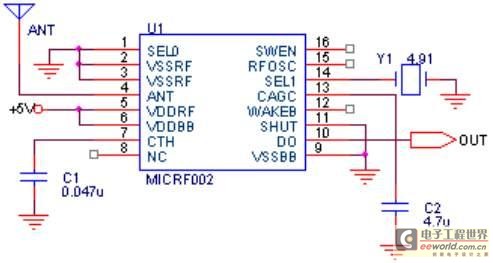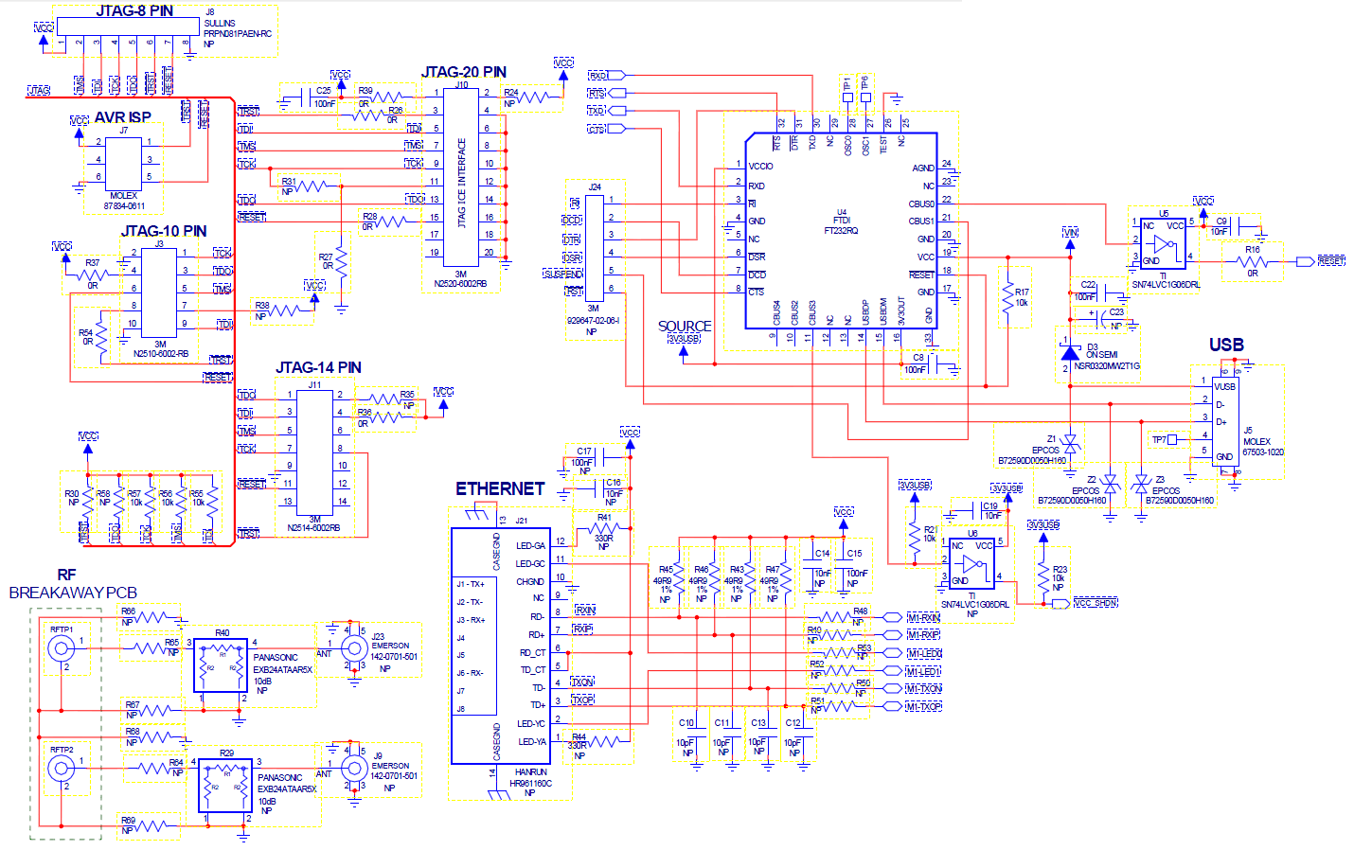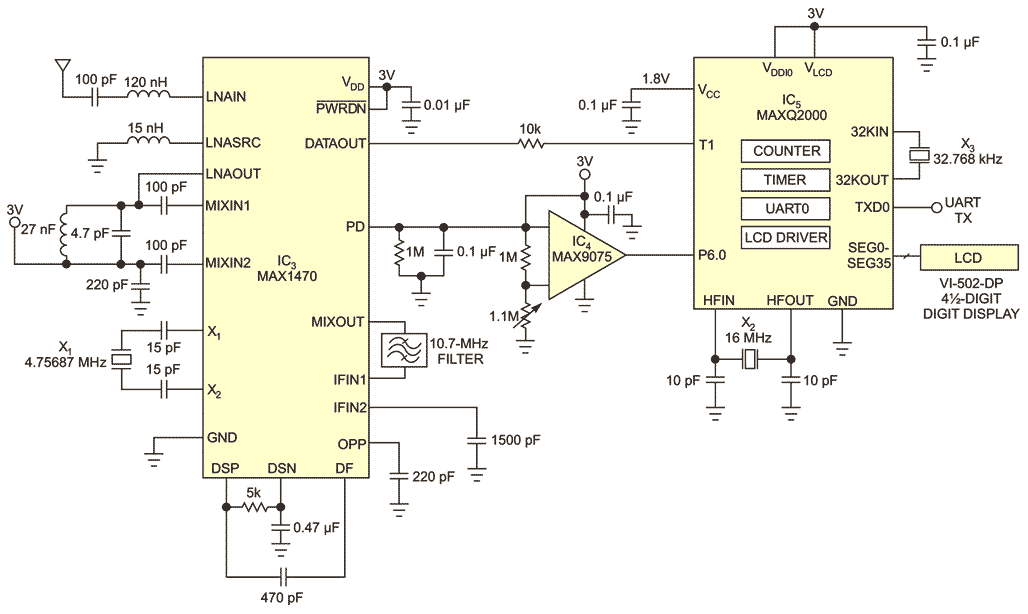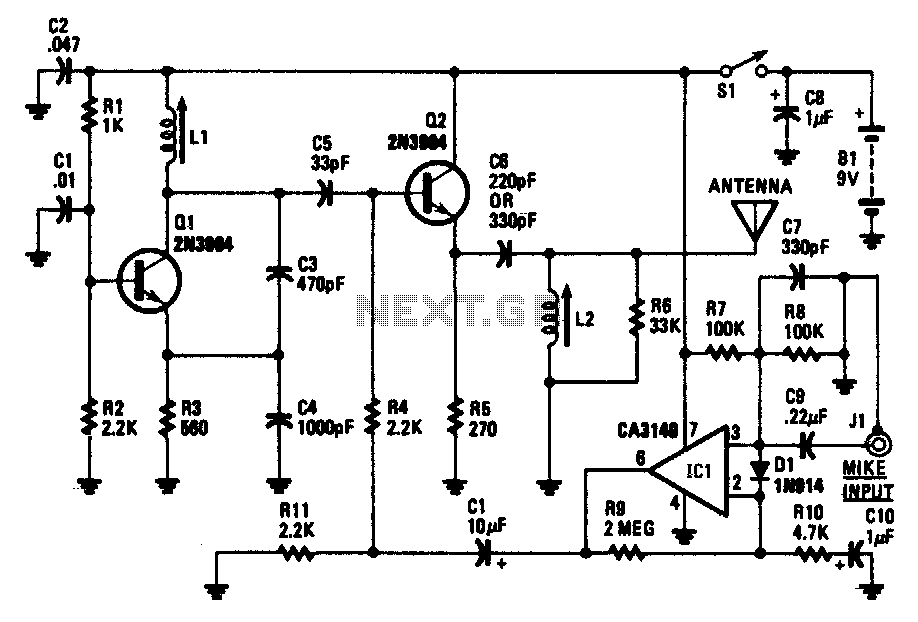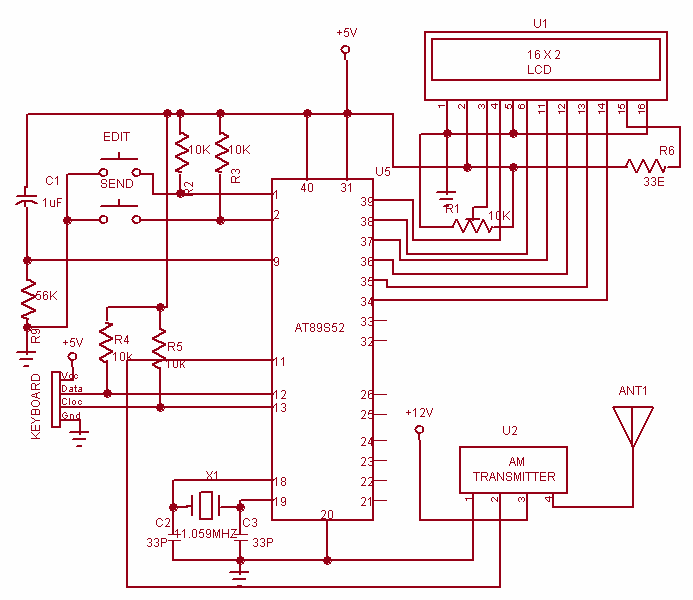
FM wireless transmitters
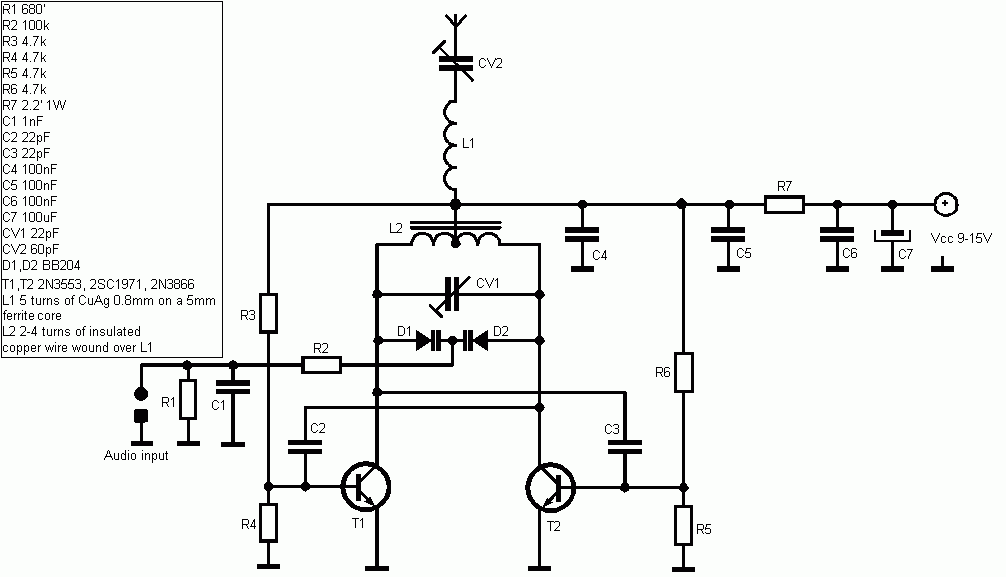
FM Broadcast Audio Transmitter. The circuit includes a frequency-modulated oscillator, an audio preamplifier with pre-emphasis to provide the frequency-modulating signal, and a buffer amplifier to drive the antenna connector. The FM radio pirate introduction to community radio electronics presents a design for a 40W broadband VHF RF power amplifier for FM broadcast. A high-quality, noise-free, wireless FM transmitter/receiver can be constructed using the LM566 VCO and LM565 PLL detector. The LM566 VCO converts the program material into FM format, which is then transformer-coupled to standard power lines. At the receiver end, the material is detected from the power lines and demodulated by the LM565. A simple FM telephone bug transmitter, when connected to a phone line, transmits anything on that line (except the dial tone) to any FM radio. The frequency can be tuned from 88 to about 94 MHz, with a range of approximately 200 feet. The PLL bug transmitter operates at a PLL-controlled frequency, providing high stability. The frequency is digitally programmed and can be easily changed, with a range of about 50 to 150 MHz and an output power of 100 mW. A portable FM transmitter rated at 1 W includes a limiter, a microphone amplifier, and PLL digital tuning, with all components placed on a single circuit board. The RF power is switchable between 1 W (HI) and 0.2 W (LO). The stereo FM transmitter, known as the Micromitter, is capable of broadcasting good quality signals over a range of approximately 20 meters, making it ideal for broadcasting music from a CD player or other sources to be picked up in another location. Additionally, a voice-activated FM transmitter combines a sound-activated switch with an FM transmitter, allowing the user to set the sound level for activation. This two-stage transmitter requires tuning for optimal results.
The FM broadcast audio transmitter circuit is designed to enable the transmission of audio signals over FM frequencies, which is essential for community radio and other broadcasting applications. The core of the transmitter is a frequency-modulated oscillator that generates the carrier frequency, modulated by the audio signal to encode the information to be transmitted. The audio preamplifier with pre-emphasis enhances the higher frequencies of the audio signal, ensuring clarity and reducing noise during transmission. A buffer amplifier is employed to match the impedance of the antenna, allowing for efficient signal transfer and minimizing losses.
The LM566 VCO serves as a crucial component in generating frequency modulation by converting audio signals into an FM format. The output of the LM566 is coupled to the power lines through a transformer, enabling the transmission of audio signals without the need for extensive wiring. The LM565 PLL detector at the receiving end demodulates the signals, recovering the original audio content for playback.
The FM telephone bug is a straightforward yet effective device that captures audio from a phone line, enabling covert transmission to FM radios within range. With a tunable frequency from 88 to 94 MHz and a range of 200 feet, it allows for discreet monitoring of conversations.
The PLL bug transmitter enhances stability in frequency control, utilizing a digitally programmed frequency that can be adjusted easily. This flexibility is advantageous for applications requiring precise frequency settings and reliable transmission.
The portable FM transmitter, rated at 1 W, is compact and versatile, featuring a limiter for signal integrity and a microphone amplifier for direct audio input. The switchable RF power settings provide adaptability for various broadcasting needs.
The stereo FM Micromitter is engineered for high-quality audio transmission over short distances, making it suitable for personal or small-scale broadcasting applications. Its design facilitates ease of use with standard audio sources.
Finally, the voice-activated FM transmitter exemplifies innovation in sound-activated technology, allowing for automatic transmission based on detected audio levels. This feature enhances usability in environments where manual operation may be impractical. Overall, these components and designs represent a comprehensive approach to FM broadcasting and transmission technology.FM Broadcast Audio Transmitter The circuit consists of a frequency modulated oscillator, an audio preamplifier with pre emphasis to supply the frequency modulating signal, and a buffer amplifier to drive the antenna connector FM radio pirate Introduction to Community Radio Electronics, A Design for a 40W broadband VHF RF Power Amplifier for FM bro adcast, How to make an Weatherproof Vertically Polarised Omnidirectional Aerial FM Remote Speaker System A high quality, noise free, wireless FM transmitter/receiver may be made using the LM566 VCO and LM565 PLL Detector. The LM566 VCO is used to convert the program material into FM format, which is then transformer coupled to standard power lines.
At the receiver end the material is detected from the power lines and demodulated by the LM565, pdf file FM Telephone Bug a simple transmitter that when connected to a phone line, will transmit anything on that line (execpt the dial tone) to any FM radio. The frequency can be tuned from 88 to about 94Mhz and the range is about 200 feet PLL bug transmitter the frequency of this transmitter is PLL controlled which makes it very stable.
The frequency is programmed in digitally way and can be changed very easy. Frequency range is about 50 to 150 MHz and the output power 100mW Portable FM transmitter 1 W This small FM transmitter includes a limiter, a microphone amplifier and a PLL digital tuning. All the parts are placed on one circuit board. The RF power is switchable between 1 W (HI) and 0, 2 W (LO) Stereo FM Transmitter This new stereo FM Micromitter is capable of broadcasting good quality signals over a range of about 20 metres.
It`s ideal for broadcasting music from a CD player or from any other source so that it can be picked up in another location Voice Activated FM Transmitter A sound activated switch and an FM transmitter joined together to make a voice activated FM transmitter. Set the level of sound that it will respond to. Two stage transmitter needs tuning to get best results, pdf file 🔗 External reference
The FM broadcast audio transmitter circuit is designed to enable the transmission of audio signals over FM frequencies, which is essential for community radio and other broadcasting applications. The core of the transmitter is a frequency-modulated oscillator that generates the carrier frequency, modulated by the audio signal to encode the information to be transmitted. The audio preamplifier with pre-emphasis enhances the higher frequencies of the audio signal, ensuring clarity and reducing noise during transmission. A buffer amplifier is employed to match the impedance of the antenna, allowing for efficient signal transfer and minimizing losses.
The LM566 VCO serves as a crucial component in generating frequency modulation by converting audio signals into an FM format. The output of the LM566 is coupled to the power lines through a transformer, enabling the transmission of audio signals without the need for extensive wiring. The LM565 PLL detector at the receiving end demodulates the signals, recovering the original audio content for playback.
The FM telephone bug is a straightforward yet effective device that captures audio from a phone line, enabling covert transmission to FM radios within range. With a tunable frequency from 88 to 94 MHz and a range of 200 feet, it allows for discreet monitoring of conversations.
The PLL bug transmitter enhances stability in frequency control, utilizing a digitally programmed frequency that can be adjusted easily. This flexibility is advantageous for applications requiring precise frequency settings and reliable transmission.
The portable FM transmitter, rated at 1 W, is compact and versatile, featuring a limiter for signal integrity and a microphone amplifier for direct audio input. The switchable RF power settings provide adaptability for various broadcasting needs.
The stereo FM Micromitter is engineered for high-quality audio transmission over short distances, making it suitable for personal or small-scale broadcasting applications. Its design facilitates ease of use with standard audio sources.
Finally, the voice-activated FM transmitter exemplifies innovation in sound-activated technology, allowing for automatic transmission based on detected audio levels. This feature enhances usability in environments where manual operation may be impractical. Overall, these components and designs represent a comprehensive approach to FM broadcasting and transmission technology.FM Broadcast Audio Transmitter The circuit consists of a frequency modulated oscillator, an audio preamplifier with pre emphasis to supply the frequency modulating signal, and a buffer amplifier to drive the antenna connector FM radio pirate Introduction to Community Radio Electronics, A Design for a 40W broadband VHF RF Power Amplifier for FM bro adcast, How to make an Weatherproof Vertically Polarised Omnidirectional Aerial FM Remote Speaker System A high quality, noise free, wireless FM transmitter/receiver may be made using the LM566 VCO and LM565 PLL Detector. The LM566 VCO is used to convert the program material into FM format, which is then transformer coupled to standard power lines.
At the receiver end the material is detected from the power lines and demodulated by the LM565, pdf file FM Telephone Bug a simple transmitter that when connected to a phone line, will transmit anything on that line (execpt the dial tone) to any FM radio. The frequency can be tuned from 88 to about 94Mhz and the range is about 200 feet PLL bug transmitter the frequency of this transmitter is PLL controlled which makes it very stable.
The frequency is programmed in digitally way and can be changed very easy. Frequency range is about 50 to 150 MHz and the output power 100mW Portable FM transmitter 1 W This small FM transmitter includes a limiter, a microphone amplifier and a PLL digital tuning. All the parts are placed on one circuit board. The RF power is switchable between 1 W (HI) and 0, 2 W (LO) Stereo FM Transmitter This new stereo FM Micromitter is capable of broadcasting good quality signals over a range of about 20 metres.
It`s ideal for broadcasting music from a CD player or from any other source so that it can be picked up in another location Voice Activated FM Transmitter A sound activated switch and an FM transmitter joined together to make a voice activated FM transmitter. Set the level of sound that it will respond to. Two stage transmitter needs tuning to get best results, pdf file 🔗 External reference
